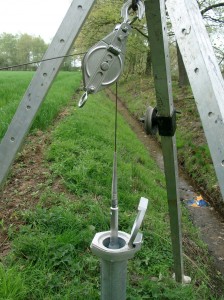Geophysical &Â Physico-Chemical Depth Profiling of Groundwater
The selection of optimal well sites, well types and screen levels/depth requires a high qualified geophysical and physio-chemical investigation which assures a sustainable groundwater abstraction in terms of quantity and quality.

Geophysical Well Logging
The geophysical well logging is aimed at recording important physical properties of the aquifer like the lithology (clay content, porosity), borehole diameter and water-bearing of the penetrated geological layers. A log recording is made by lowering a measurement tool to the bottom of the well, and then doing measurements while slowly pulling the tool up from the bottom. The signals from the logging tools are registered continuously in a computer. To get a complete set of information from the well, 3-6 different tools can be used, depending on what information is required.
Different log tools give information on different physical properties, and therefore a number of different tools is available. KRIETER WATER & ENVIRONMENT offers a combination of the most effective log tools:
Caliper log: This tool measures the diameter of the well. The log is typically measured in open holes, and can be used to detect cavities that has occurred in the drilling process. This information can be useful for the interpretation of other log-types, since increase in diameter will increase the distance from the tool to the geological formations. For determination of flow-rate in a well, the information about diameter is also important.
Gamma-log: This log tool measures the natural radioactive radiation. The gamma radiation reflects the clay content in the geological layers, and therefore the gamma-log can be used for determination of clay layers, and clay content in e.g. sandy layers. Some bentonite based sealing materials can also be detected with a gamma-log. The gamma-log can, as one of the only tools, be applied in both open wells and cased wells, no matter what casing material is used.
Resistivity log: Measures the electrical resistivity. In combination with the gamma-log, the resistivity log is a good tool for determination of lithology. The log will give information about the true resistivity of the geological layers, and therefore gives opportunity to understand the relation between surface resistivity surveys and actual geology. A resistivity log needs electrical contact to the layers and can therefore only be made in open wells without casing.
Induction log: Measures the electrical conductivity. This can be recalculated to electrical resistivity. The advantage with the induction log is, that it can be made in cased wells, if the casing is non-metallic.
Flow-log: The flow-log reveals in which levels the water comes enters the well. In hard rock wells, the main part of the water will often come from open fractures, and here the flow-log can be used to determine the position of the water-bearing fractures. To calculate actual flow-rates, a caliper-log is needed. The flow-log can also be used in cased wells with screens, in case knowledge about specific level of water inflow is required.
Optical Televiewer: The Optical televiewer provides a continuous, detailed and orientated 360º image of the borehole walls using a unique optical imaging system. This can be rapidly interpreted to obtain a complete feature analysis that includes dip, strike, frequency and fracture aperture.
Borehole Camera: Video inspection of a well can be used to determine the condition of the well (e.g. leaks in the tubing and damage to the screen), and can also be used in wells where no information exists on the construction.

Physico-Chemical Groundwater Depth Profiling
While the geophysical well logging reveals information on the physical properties of the aquifer, the physico-chemical groundwater depth profiling is monitoring important physico-chemical and chemical properties of the groundwater (column) in a depth profile.
KRIETER WATER & ENVIRONMENT has a very long experience in groundwater chemistry and especially also in layered groundwater (physico-chemical layers: redox potential, pH, element concentrations etc.).
 This knowledge of the physico-chemical zoning of the groundwater is a key not only for the well construction, but also for the well operation. Avoiding the abstraction from poor quality water zones (high contents of iron, etc) will ensure the yield of the well over a long time and will save high expenses for water treatment, well restoration or at worst the construction of a new well.
This knowledge of the physico-chemical zoning of the groundwater is a key not only for the well construction, but also for the well operation. Avoiding the abstraction from poor quality water zones (high contents of iron, etc) will ensure the yield of the well over a long time and will save high expenses for water treatment, well restoration or at worst the construction of a new well.
KRIETER WATER & ENVIRONMENT has developed own muli-level-sampling tools. The simultaneous sampling in different depths/zones with several specially controlled pumps avoids hydraulic short circuits (mixture of waters from different depths) and ensures the depth-specific sampling. During pumping the sensitive parameters temperature, conductivity, pH and redox-potential are measured online. Additional water is sampled (and if necessary conditioned) for the chemical, radioactivity and bacterial analysis.
